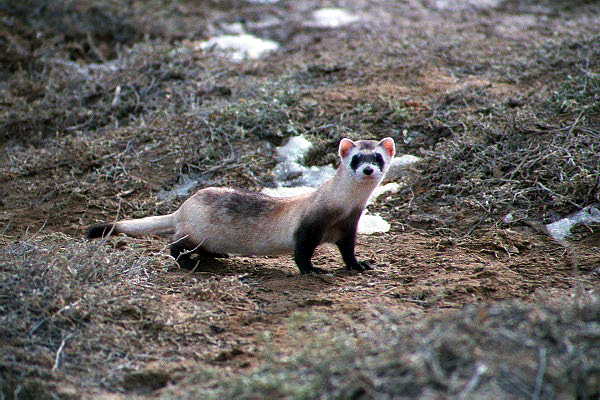|
| 질의: American marten | 결과: 20번째/29 | |
Black-footed Ferret (Mustela nigripes) - Wiki
| 제목: | Black-footed Ferret (Mustela nigripes) - Wiki
| |

| 해상도: 600x400
파일크기: 127007 Bytes
촬영일: 2007:06:07 14:01:31
등록시간: 2007:06:07 14:02:14
|
Black-footed Ferret
From Wikipedia, the free encyclopedia
[Photo] Black-footed Ferret (Mustela nigripes). Source: http://www.blm.gov/wo/st/en.html
The Black-footed Ferret (Mustela nigripes) is a small carnivorous North American mammal closely related to the Steppe Polecat of Russia, and a member of the diverse family Mustelidae which also includes weasels, mink, polecats, martens, otters, and badgers. It should not be confused with the domesticated ferret.
The Black-footed Ferret is an endangered mammal in North America, according to the U. S. Fish and Wildlife Service (USFWS). They became extinct in the wild in Canada in 1937, and were classified as endangered in the U.S. in 1967. The last known wild population was taken into captivity in the mid-1980s, a few years after its accidental discovery in Wyoming. Release of captive animals has successfully re-introduced the species to parts of its former habitat but the populations are still small.
Physical description
Black-footed Ferrets are about 45 cm (18 in) long, with a furry 15 cm (6 in) tail, and they weigh roughly 1 kg (2 lbs). Like most members of the family, they are very low to the ground with an elongated body and very short legs. Their fur is white at the base but darkens at the tips, making them appear yellowish-brown overall, with black feet and tail-tip, and a distinctive black face mask. These blend in well with the prairie ecosystem in which they live. They do not change their habitat over the seasons. They eat insects, prarie dogs, and gophers.
Ecology and behavior
They are nocturnal hunters that are almost entirely dependent on a plentiful supply of prairie dogs to prey on, and shelter in a prairie dog burrow during the day. A single family of four Black-footed Ferrets eats about 250 prairie dogs each year and cannot survive without access to large colonies of them.
Conservation status
The loss of their prairie grassland habitat, the drastic reduction of prairie dog numbers (through both habitat loss and poisoning), and the effects of canine distemper and sylvatic plague (similar to bubonic plague) have all contributed to the near-extinction of the species during the 19th and 20th centuries. Even before their numbers declined, Black-footed Ferrets were rarely seen: they weren't officially recognized as a species by scientists until 1851, following publication of a book by naturalist John James Audubon and Rev. John Bachman. Even then, their existence was questioned since no other Black-footed Ferrets were reported for over twenty years.
In 1981, a very small population of about 130 animals was discovered near Meeteetse, Wyoming. Soon after discovery, the population began a rapid decline due to disease. By 1986, the Wyoming Game and Fish Department led a cooperative program to capture the 18 remaining animals and begin an intensive captive breeding program. At that time, the entire world population amounted to about 50 individuals in captivity.
U.S. federal and state agencies in cooperation with private landowners, conservation groups, Native Americans, and North American zoos, have been actively reintroducing ferrets back into the wild since 1991. Beginning in Wyoming, reintroduction efforts have since expanded to sites in Montana, South Dakota, Arizona, Utah, Colorado and Chihuahua, Mexico. Proposed reintroduction sites have been identified in Canada. However, in May 2000, the Canadian Species at Risk Act listed the black-footed ferret an being an extirpated species in Canada.
As of 2005, conservationists estimate a total wild population of 400 black-footed ferrets in the United States. While the IUCN formally classifies them as extinct in the wild, this is due to the last update to the redlist assessment having been in 1996 when the species was indeed only surviving in captivity (Mustelid Specialist Group, 1996). The Black-footed Ferret is listed as "Endangered" under the Endangered Species Act since September 20, 2005.
The recovery plan calls for the establishment of 10 or more separate, self-sustaining wild populations. Biologists hope to have 1500 Black-footed Ferrets established in the wild by the year 2010, with at least 30 breeding adults in each population. Meeting this objective would allow the conservation status of the species to be downgraded to threatened.
http://en.wikipedia.org/wiki/Black-footed_Ferret
| The text in this page is based on the copyrighted Wikipedia article shown in above URL. It is used under the GNU Free Documentation License. You may redistribute it, verbatim or modified, providing that you comply with the terms of the GFDL. |
|
댓글 |
|---|
| | Alex Fetcher |
|
Great site!
bdc71d3214bd100b116fbc2868331bb9 |
| | 손님 |
|
Scientific Name: Mustela nigripes (Audubon & Bachman, 1851)
Common Names: Black-footed Ferret, American Polecat, Prairie Dog Hunter; [French] Putois À Pieds Noirs; [Spanish] Turón Patinegro Americano
Synonyms: Putorius nigripes Audubon and Bachman, 1851 |
^o^
동물그림창고 똑똑전화 누리집
^o^
|
|
|